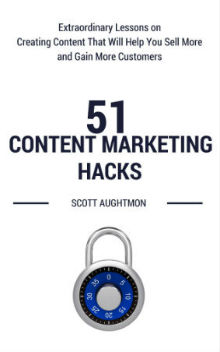I admit it.
I was a big fan of the original X-Files TV show.
I loved the mysterious story lines and how they had a lot of that old school “Twilight Zone” feel and subject matter.
I also loved the way they had Agent Mulder and Agent Scully both represent opposite sides of the argument of whether there are things that exist beyond the understanding of science.
I saw that they have brought back a new version of the show, but I haven’t gotten a chance to see any of the first episodes (yet).
But I am not just bringing up the show to confess my love of the original show.
I wanted to bring it up, because I just saw something related to the show that I couldn’t believe.
Let me explain.
The Most Powerful Type of Content Marketing
I’ve mentioned this before, but I need to say it again.
Even though most content marketers focus mainly on content that is created by them or their team, the most powerful type of content marketing is: content created by others.
This brings me to the reason I wanted to bring up the X-Files.
I came across this news story...
CIA: Government Agency Shares UFO Documents Declassified in 1978, Calls Them ‘X-Files’
Did you catch that?
The CIA has decided to declassify hundreds of documents in 1978 detailing the Agency’s investigations into Unidentified Flying Objects (UFOs) and they decided to call them “X-Files”! (These documents date mostly from the late 1940s and 1950s.)
They mentioned these documents in a blog post on their site called Take a Peek Into Our “X-Files” that was posted on January 21st.
This is amazing.
The timing and the free promotion of the show are better than anything that Fox could have paid for!
(The first episode of the new X-Files appeared on January 24th, just three days after the CIA blog post .)
And, in case you’re unaware, this the CIA didn’t just mention the X-Files in the title of their blog.
It was the whole theme of their post!
Listen to the CIA description for yourself…
To help navigate the vast amount of data contained in our FOIA UFO collection, we’ve decided to highlight a few documents both skeptics and believers will find interesting. Below you will find five documents we think X-Files character Agent Fox Mulder would love to use to try and persuade others of the existence of extraterrestrial activity. We also pulled five documents we think his skeptical partner, Agent Dana Scully, could use to prove there is a scientific explanation for UFO sightings.
It’s a direct reference to the shows characters!
And when you see the blog post itself, you’ll see that they’ve listed 5 documents that Mulder would like and 5 documents that Scully would like.
Besides the publicity, there is a really important reason why this kind of content is so powerful.
The Connection Between Social Proof and Mirror Neurons
In chapter 32 of my book 51 Content Marketing Hacks, in a chapter called The 4 Commandments of Socially-Created Content, I reveal why content created by others is so powerful.
I do that by sharing a quote from the book, “Grouped: How Small Groups of Friends are the Key to Influence on the Social Web,” by author Paul Adams.
Let me share that quote again…
“When people are unsure about how they should act or feel, they observe people around them. This is known as social proof. Research shows that when we observe others, our brains simulate what they are feeling.”
Later, Adams explains that, “Social proof can be used to show people the preferred course of action or appropriate behavior.”
Then I say…
It reminds me of something Daniel Goleman said in his (also great) book, “Social Intelligence:”
Our brains contain recently discovered cells called “mirror neurons.” These cells act sort of like a neural-WiFi. They are what allow us to pick up on, feel, and mirror what others are feeling. When you observe one person telling an exciting story and see their friend’s face and body begin to respond with similar signs of excitement, that’s the mirror neurons in action!
The way Goleman describes this phenomenon is very powerful: “Emotions are contagious.”
Really think about what these two authors are saying: The most powerful type of influence is when a person shares emotions, actions, and feelings with another. It influences us on a deep, even subconscious, level.
Did you catch that?
- People look to others when they are unsure about how to act or feel.
- And because our brains contain mirror neurons, emotions are contagious. We pick up on and mirror what others are feeling!
That’s the reason the CIA blog post about their “X-Files” is such powerful content marketing for the new X-Files show!
A top agency in the government is talking about this TV show in a playful and even realistic way.
This will cause more people to want to watch the show than might have originally been interested.
And it will cause the story lines on the show to have more emotional impact.
That’s what makes it such powerful content marketing for the new show!
So let this all by a reminder for you: When you are coming up with your content marketing strategy for 2016, make sure to do everything you can to include content created by others!
(NOTE: If you want to know more about how to get others to create content for you, then grab a copy of my book and read that chapter. In it, I share “four ways to prime the pump”.)








